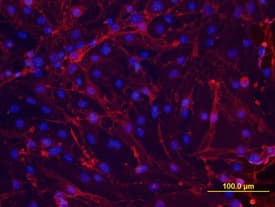Mouse Thrombomodulin/BDCA-3 Antibody
R&D Systems, part of Bio-Techne | Catalog # MAB3894


Key Product Details
Species Reactivity
Validated:
Cited:
Applications
Validated:
Cited:
Label
Antibody Source
Product Specifications
Immunogen
Leu17-Ser517
Accession # P15306
Specificity
Clonality
Host
Isotype
Scientific Data Images for Mouse Thrombomodulin/BDCA-3 Antibody
Thrombomodulin/BDCA-3 in bEnd.3 Mouse Cell Line.
Thrombomodulin/BDCA-3 was detected in immersion fixed bEnd.3 mouse endothelioma cell line using Mouse Thrombomodulin/BDCA-3 Monoclonal Antibody (Catalog # MAB3894) at 10 µg/mL for 3 hours at room temperature. Cells were stained using the NorthernLights™ 557-conjugated Anti-Rat IgG Secondary Antibody (red; Catalog # NL013) and counterstained with DAPI (blue). View our protocol for Fluorescent ICC Staining of Cells on Coverslips.Thrombomodulin/BDCA-3 in Mouse Heart.
Thrombomodulin/BDCA-3 was detected in perfusion fixed frozen sections of mouse heart using 25 µg/mL Mouse Thrombomodulin/BDCA-3 Monoclonal Antibody (Catalog # MAB3894) overnight at 4 °C. Tissue was stained with the Anti-Rat HRP-DAB Cell & Tissue Staining Kit (brown; Catalog # CTS017) and counterstained with hematoxylin (blue). View our protocol for Chromogenic IHC Staining of Paraffin-embedded Tissue Sections.Detection of Thrombomodulin/BDCA-3 in bEnd.3 Mouse Cell Line by Flow Cytometry.
bEnd.3 mouse endothelioma cell line was stained with Mouse Thrombomodulin/BDCA-3 Monoclonal Antibody (Catalog # MAB3894, filled histogram) or isotype control antibody (Catalog # MAB0061, open histogram), followed by Phycoerythrin-conjugated Anti-Rat IgG F(ab')2Secondary Antibody (Catalog # F0105B).Applications for Mouse Thrombomodulin/BDCA-3 Antibody
CyTOF-ready
Flow Cytometry
Sample: bEnd.3 mouse endothelioma cell line
Immunocytochemistry
Sample: Immersion fixed bEND.3 mouse endothelioma cell line
Immunohistochemistry
Sample: Perfusion fixed frozen sections of mouse kidney and heart
Western Blot
Sample: Recombinant Mouse Thrombomodulin/THBD/CD141 (Catalog # 3894-PA)
under non-reducing conditions only
Reviewed Applications
Read 2 reviews rated 5 using MAB3894 in the following applications:
Formulation, Preparation, and Storage
Purification
Reconstitution
Formulation
Shipping
Stability & Storage
- 12 months from date of receipt, -20 to -70 °C as supplied.
- 1 month, 2 to 8 °C under sterile conditions after reconstitution.
- 6 months, -20 to -70 °C under sterile conditions after reconstitution.
Background: Thrombomodulin/BDCA-3
Encoded by the THBD gene, Thrombomodulin is also known as CD141 antigen. The deduced amino acid sequence of mouse THBD predicts a signal peptide (aa 1 to 16) and a mature chain (aa 17 to 577) that consists of the following domains: C-type lectin (aa 31 to 167), EGF-like (aa 240 to 280, aa 283 to 323, aa 324 to 362, aa 364 to 404, aa 405 to 439, and aa 440 to 480), transmembrane (aa 518 to 541) and cytoplasmic (aa 542 to 577) (1). The R&D Systems rmTHBD consists of aa 17 to 517, corresponding to the extracellular portion of the type I membrane protein. Predominantly synthesized by vascular endothelial cells, THBD inhibits coagulation and fibrinolysis (2‑4). It functions as a cell surface receptor and an essential cofactor for active thrombin, which in turn activates protein C and thrombin-activatable fibrinolysis inhibitor (TAFI), also known as carboxypeptidase B2 (CPB2). Activated protein C (APC), facilitated by protein S, degrades coagulation factors Va and VIIIa, which are required for thrombin activation. Activated CPB2 cleaves basic C-terminal amino acid residues of its substrates, including fibrin, preventing the conversion of plasminogen to plasmin. In addition, THBD gene polymorphisims are associated with human disease and THBD plays a role in thrombosis, stroke, arteriosclerosis, and cancer (5). For example, increased serum levels of THBD, due to protease cleavage, have been associated with smoking, cardiac surgery, atherosclerosis, liver cirrhosis, diabetes mellitus, cerebral and myocardial infarction, and multiple sclerosis (6).
References
- Dittman, W.A. and P.W. Majerus (1989) Nucleic Acids Res. 17:802.
- Van de Wouwer, M. et al. (2004) Arterioscler. Thromb. Vasc. 24:1374.
- Wu, K.K. et al. (2000) Ann Med. 32:73.
- Li, Y.H. et al. (2006) Cardiovasc. Hematol. Agents Med. Chem. 4:183.
- Weiler, H. and B.H. Isermann (2003) J. Thromb. Haemost. 1:1515.
- Califano, F. et al. (2000) Eur. Rev. Med. Pharmacol. Sci. 4:59.
Alternate Names
Gene Symbol
UniProt
Additional Thrombomodulin/BDCA-3 Products
Product Documents for Mouse Thrombomodulin/BDCA-3 Antibody
Product Specific Notices for Mouse Thrombomodulin/BDCA-3 Antibody
For research use only

